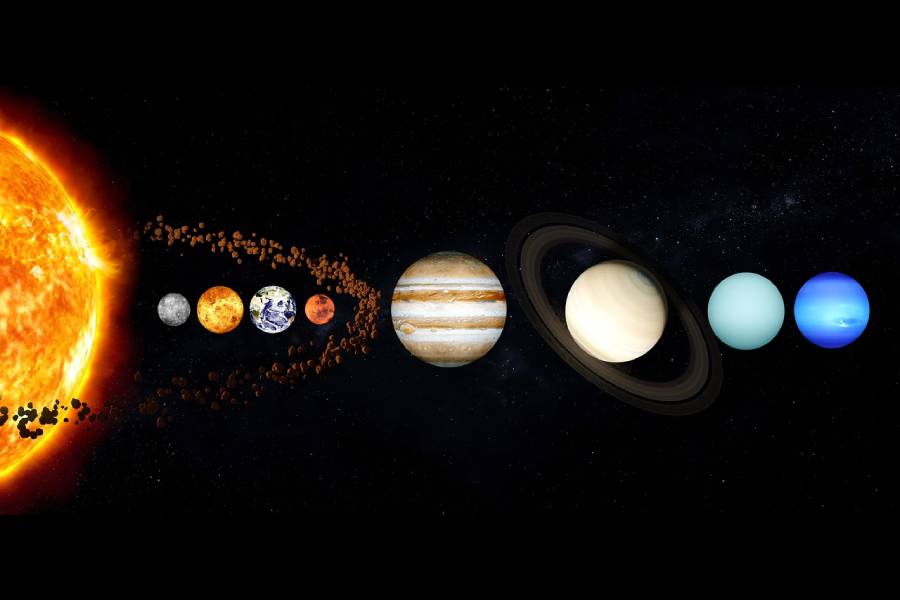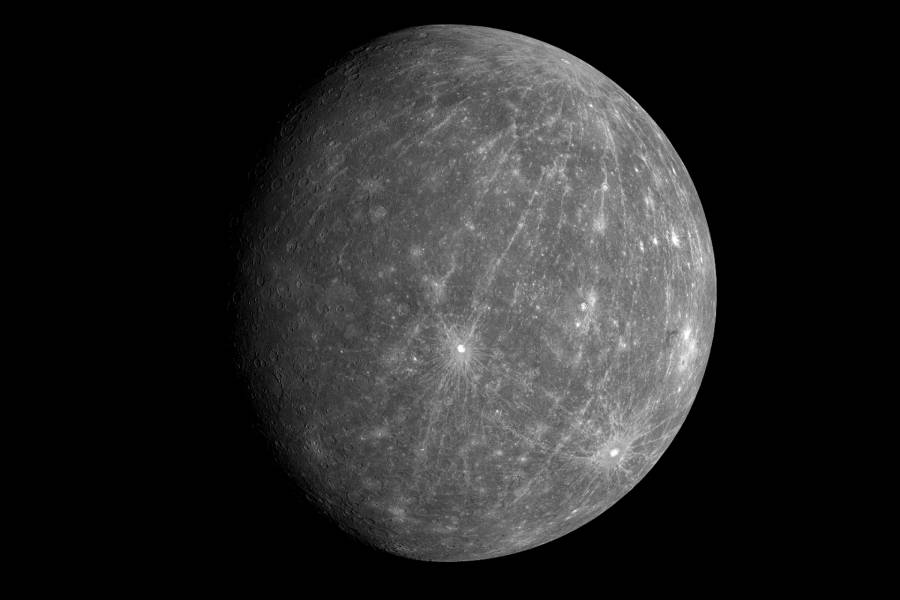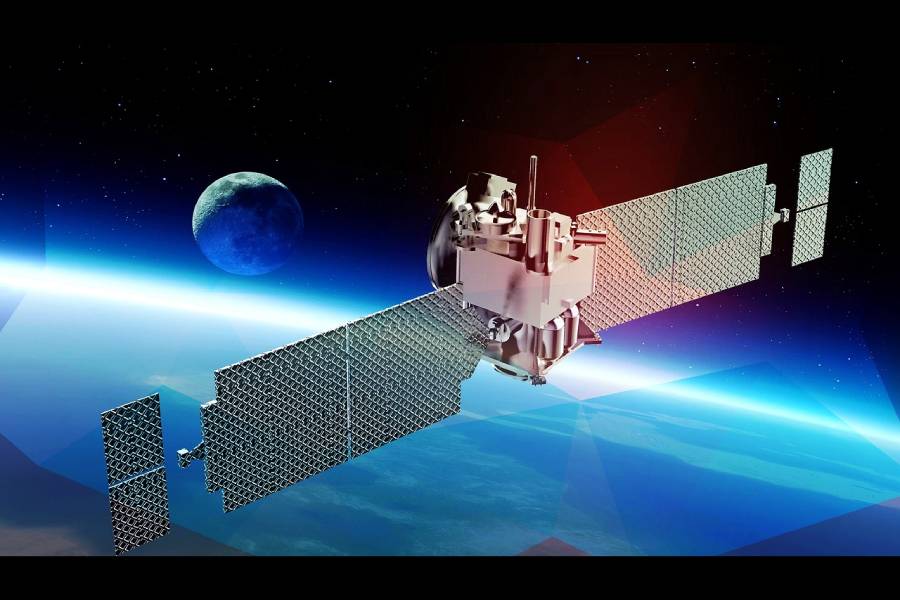In the theater of our solar system, each planet plays its distinctive role, but none quite as mysteriously as Mercury. Nestled closest to the Sun, Mercury carries secrets that continue to intrigue and astound astronomers and space enthusiasts.
This enigmatic planet, named after the fleet-footed messenger of the Roman gods, occupies a special place in the night sky. Its unique characteristics and peculiarities have fascinated astronomers and space enthusiasts for centuries.
From its extreme temperature swings to its mesmerizing surface, this small, rocky planet invites us to explore its many facets. But why is it essential to explore the intricacies of this small, rocky world tucked away in the inner reaches of the solar system?
Delving into the facts about Mercury not only satisfies our natural curiosity about the cosmos but also yields invaluable insights into the history of our solar system, the intricate processes of planetary formation, and even the hidden secrets of our very own Earth.
Facts About Mercury
Mercury is the smallest planet in our solar system and the closest to the Sun. It’s a rocky world with a diameter of about 3,032 miles (4,880 kilometers), making it only slightly larger than the Earth’s moon.
Due to its proximity to the Sun, Mercury orbits at a distance of approximately 36 million miles (57.9 million kilometers) and takes just 88 Earth days to complete one orbit.
10 Top Facts About Mercury
Mercury, our closest planetary neighbor to the Sun, has long captivated our imagination with its extraordinary characteristics and puzzling secrets. In this exploration, we’ll embark on a journey to uncover the most intriguing facts about Mercury, shedding light on the mysteries that make this planet a compelling subject of study and discovery.

1. Mercury is the closest planet to the sun
Mercury claims the title of the closest planet to our blazing celestial furnace, the Sun. Its proximity to the Sun has a profound impact on its surface conditions, leading to extreme temperatures that vary dramatically between day and night.
2. Mercury is a rocky planet
Unlike the gas giants in our solar system, such as Jupiter and Saturn, Mercury is a rocky planet. It shares this classification with Earth and Mars, as it is primarily composed of solid material, making it a terrestrial planet.
3. Mercury has a crater named after Dr. Seuss
One of the most charming and whimsical features on Mercury is a crater named after the beloved children’s book author, Dr. Seuss.
The “Seuss” crater showcases the playful spirit of planetary science, and its bright, irregularly shaped central peak has a striking resemblance to some of the whimsical creatures found in Dr. Seuss’s imaginative stories.
4. Mercury’s extreme temperatures
Due to its lack of a substantial atmosphere to trap heat, Mercury experiences extreme temperature fluctuations. Daytime temperatures on the sunlit side of the planet can soar to a scorching 800°F (430°C).
However, as night falls and Mercury plunges into darkness, temperatures plummet to a bone-chilling -290°F (-180°C).
5. Mercury’s unusual day-night cycle
Mercury’s rotation is unusually slow and synchronized with its orbit around its axis, resulting in a day-night cycle, unlike any other planet in our solar system. A solar day on Mercury, from one sunrise to the next, lasts about 176 Earth days every two Mercurian solar years (each having 88 Earth days).
However, a single day on Mercury, encompassing one complete rotation on its axis, lasts about 59 Earth days.
6. Presence of scarps
Mercury’s surface is marked by the presence of long cliffs known as scarps. These geological features, stretching for hundreds of kilometers, formed as the planet’s interior cooled and contracted, causing its surface to crack and form these unique terrain features.
7. Polar ice on a scorching world
Despite its proximity to the Sun, Mercury harbors pockets of water ice in permanently shadowed regions near its poles. These areas remain perpetually shaded from the Sun’s intense heat, allowing water ice to accumulate over billions of years.
8. Mercury’s unique orbital eccentricity
Mercury’s orbit around the Sun is highly eccentric, meaning it is more elongated than circular. This eccentricity results in significant variations in its distance from the Sun during its orbit, contributing to its extreme temperature variations.
9. Mercury’s role in advancing space exploration
Mercury has played a pivotal role in advancing our understanding of the solar system. It served as the target of several space missions, including Mariner 10, MESSENGER, and BepiColombo, each contributing vital data and discoveries that continue to expand our knowledge of this intriguing planet.
10. Insights into planetary formation
Studying Mercury provides valuable insights into the processes of planetary formation and evolution. Its unique characteristics, such as its thin exosphere, provide clues about the early history of our solar system and the factors that shaped the planets within it.
Lack of Atmosphere on Mercury
One of the most striking facts about Mercury is its complete absence of a substantial atmosphere. Unlike Earth, which boasts a life-sustaining atmosphere composed mainly of nitrogen and oxygen, Mercury’s atmosphere is virtually non-existent.
It consists of only trace amounts of gases, primarily helium, and traces of hydrogen, oxygen, sodium, and potassium.
The lack of a significant atmosphere has profound implications for Mercury’s surface conditions. Without an atmosphere to trap heat, the planet experiences extreme temperature variations between its day and night sides.
Daytime temperatures on Mercury can soar to a blistering 800°F, while nighttime temperatures plummet to a frigid -290°F.

Surface Features
Mercury’s surface is a fascinating landscape of extremes. It is characterized by a vast array of impact craters, large and small, sculpted by billions of years of meteoroid and asteroid impacts.
Among these craters is the Caloris Basin, a colossal impact feature measuring over 960 miles (1,550 kilometers) in diameter, which serves as a testament to the planet’s tumultuous past.
In addition to impact craters, Mercury boasts an array of unique surface features. Scarps, or long cliffs, extend across its surface, created by the planet’s cooling and contraction over time. These scarps can reach hundreds of kilometers in length and are a testament to the planet’s geological history.
Furthermore, Mercury exhibits signs of past volcanic activity, with vast plains of solidified lava known as “smooth plains“. These volcanic plains suggest that, at some point in its history, the planet experienced volcanic eruptions that reshaped its surface.
Overall, the physical characteristics of Mercury, from its diminutive size and proximity to the Sun to its lack of atmosphere and diverse surface features, make it an intriguing world worthy of exploration and study.
Historical Exploration and Missions
Early observations from Earth
Before the era of space exploration, Mercury was a subject of fascination and study for astronomers observing it from Earth.
Early astronomers, armed with telescopes, observed the planet’s peculiar behavior as it underwent phases similar to our moon, ranging from crescent to gibbous. These observations hinted at Mercury’s proximity to the Sun and its unique characteristics.

Space missions to Mercury
Mariner 10
- In the early 1970s, NASA’s Mariner 10 spacecraft made history by becoming the first to visit Mercury.
- Mariner 10 conducted a series of flybys of the planet, capturing valuable data about its surface and environment.
- Key discoveries from Mariner 10 included detailed images of Mercury’s surface, which revealed its heavily cratered terrain and provided insights into its geological history.
MESSENGER (Mercury Surface, Space Environment, Geochemistry, and Ranging)
- Launched in 2004, NASA’s MESSENGER mission marked a significant advancement in our understanding of Mercury.
- MESSENGER became the first spacecraft to orbit Mercury, providing comprehensive data over the course of several years.
- Among its numerous achievements, MESSENGER discovered evidence of water ice in permanently shadowed craters at the planet’s poles, a surprising find given Mercury’s scorching daytime temperatures.
- The mission also helped scientists gain a deeper understanding of the planet’s geology, magnetic field, and exosphere.
BepiColombo
- Launched in 2018 by the European Space Agency (ESA) and the Japan Aerospace Exploration Agency (JAXA), BepiColombo is the most recent mission to Mercury.
- BepiColombo is a dual-spacecraft mission consisting of the Mercury Planetary Orbiter (MPO) and the Mercury Magnetospheric Orbiter (MMO).
- This ambitious mission aims to study Mercury’s magnetic field, exosphere, and surface composition in unprecedented detail, providing valuable insights into the planet’s history and formation.
Key discoveries from these missions
The missions to Mercury have yielded a wealth of information and key discoveries:
- Surface insights – Mariner 10 and MESSENGER provided detailed images of Mercury’s surface, revealing a heavily cratered terrain that bears the scars of billions of years of meteoroid and asteroid impacts.
- Geological activity – MESSENGER‘s data suggested that despite its small size and proximity to the Sun, Mercury experienced volcanic activity in the distant past, resulting in vast plains of solidified lava known as “smooth plains”.
- Water ice discovery – MESSENGER‘s discovery of water ice in polar craters challenged previous assumptions about Mercury’s scorching conditions, highlighting the presence of permanently shadowed regions where ice could accumulate.
- Magnetic field – MESSENGER confirmed the presence of a magnetic field on Mercury, a surprising finding for a planet of its size. Understanding the origin and dynamics of this magnetic field is an ongoing area of study.
- Exosphere composition – Both MESSENGER and BepiColombo have provided insights into Mercury’s tenuous exosphere, revealing the presence of elements like sodium, potassium, and calcium, which contribute to the planet’s unique chemistry.
Frequently Asked Questions
What are the major differences between Mercury and Earth’s atmospheres, and how do they affect the planets’ surface conditions?
Mercury and Earth couldn’t be more different in terms of their atmospheres. Earth boasts a thick, life-sustaining atmosphere primarily composed of nitrogen and oxygen, which helps regulate temperatures and supports life.
In stark contrast, Mercury has a virtually nonexistent atmosphere composed mainly of trace gases, unable to trap heat. This leads to extreme temperature fluctuations on Mercury’s surface, with scorching daytime highs and freezing nighttime lows.
Why is Mercury so special?
Mercury’s uniqueness lies in its proximity to the Sun and the extreme conditions it experiences. As the closest planet to the Sun, it faces relentless solar radiation, and its lack of a substantial atmosphere makes it a world of stark contrasts – sweltering heat and freezing cold.
Its peculiar orbit and slow rotation also set it apart, making it a fascinating subject of study for scientists seeking to understand planetary formation and the dynamics of celestial bodies.
What color is Mercury?
Mercury’s surface appears grayish to brownish-gray, with variations in color due to differences in the composition of its surface materials. The lack of a substantial atmosphere means that the planet doesn’t have the vibrant skies we see on Earth, and its surface colors are influenced by the abundance of rocky and metallic materials.
How did the Caloris Basin on Mercury form, and what is its significance in planetary science?
The Caloris Basin, one of Mercury’s most prominent features, is believed to have formed billions of years ago as the result of a massive impact by an asteroid or comet. It’s an enormous impact crater, measuring over 960 miles (1,550 kilometers) in diameter.
Caloris Basin’s significance in planetary science lies in its role as a natural laboratory for studying impact cratering processes and understanding the history of our solar system.
The study of this colossal feature helps us unravel the mysteries of planetary evolution and the dynamic forces that have shaped celestial bodies over eons.
Conclusion
Mercury, our nearest celestial neighbor, astounds with its unique traits. As the Sun’s closest companion, it boasts a barren, scarred surface and undergoes extreme temperature swings from scorching days to frigid nights. Its quirky day-night cycle, slow rotation, and magnetic field make it an anomaly in our solar system.
In summary, Mercury’s exceptional status as a rocky planet with no atmosphere, coupled with its proximity to the Sun, sets it apart. Its history is etched in impact craters and marked by geological activity of the past.
Exploring facts about Mercury is not just a quest for knowledge but a gateway to understanding Earth and other worlds. It challenges our preconceptions about planetary conditions and fuels our curiosity about the cosmos.
As we journey onward, Mercury beckons, a sentinel of mysteries waiting to be unraveled, reminding us of the endless marvels awaiting discovery among the stars.

